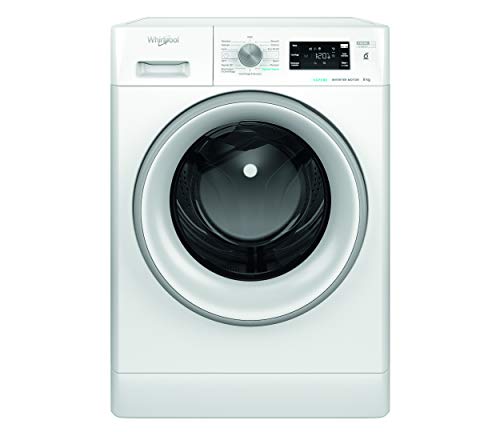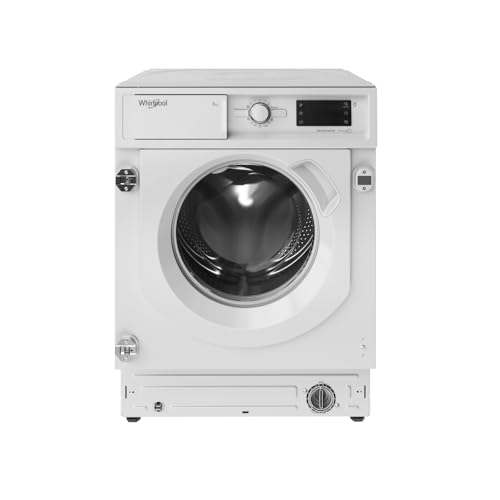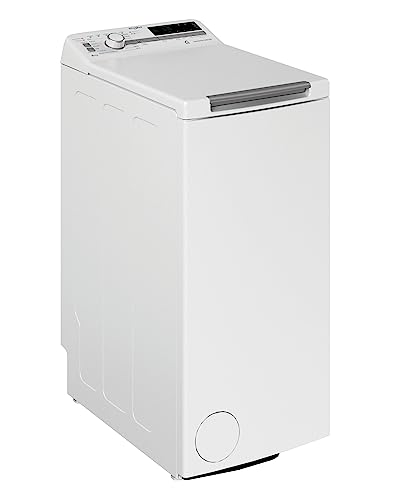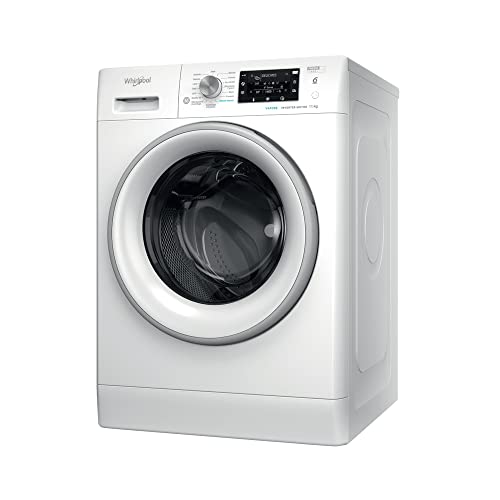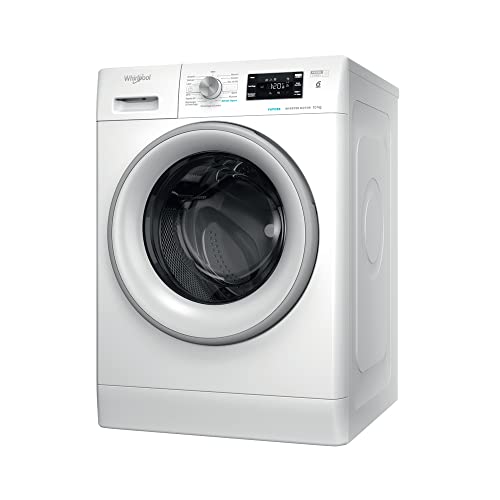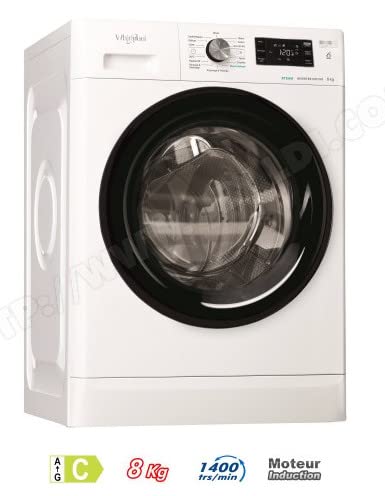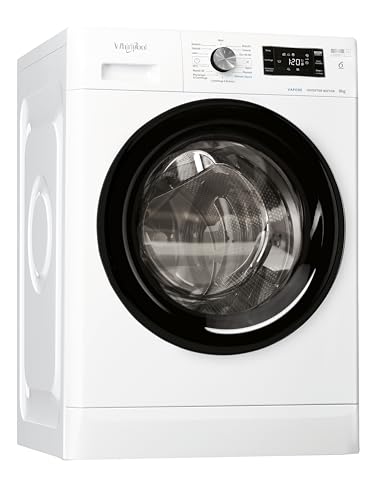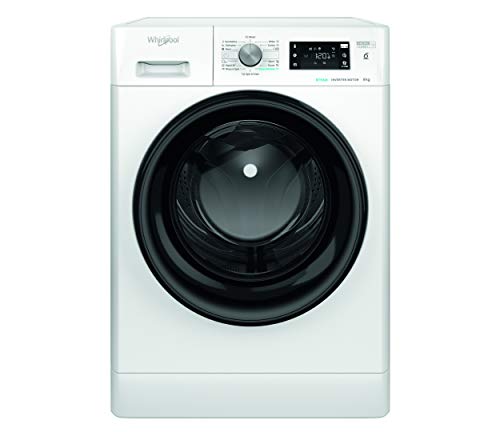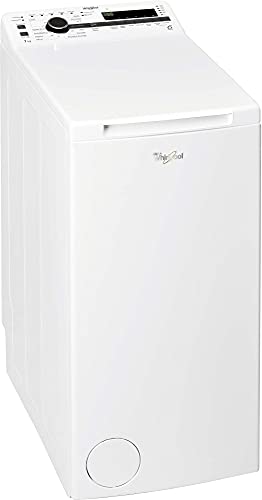Are Whirlpool washing machines good?
Whirlpool washing machines achieve a total score of 6.4 points and rank #19 among all washing machine brands.
Whirlpool washing machines have an average user rating of 7.3 points, placing them #20 in user satisfaction.
If you don’t have a specific budget, we recommend checking out washing machines from brands like Siemens, LG, or Samsung, which score higher overall.
(This ranking includes 22 brands, excluding those with fewer than 6 products in the database.)
The chart below shows the ranking of washing machine brands based on their total score.
[horizontal-chart-39866564]
The best Whirlpool washing machines (with the highest total score) are as follows.
- Whirlpool W8 W946WR Supreme Silence (Total score: 7.62 points; Capacity: 9 kg)
- Whirlpool FFB 846 SV IT FreshCare (Total score: 6.81 points; Capacity: 8 kg)
- Whirlpool BI WMWG 81484E (Total score: 6.75 points; Capacity: 8 kg)
What are the main advantages of Whirlpool washing machines?
Whirlpool washing machines offer the following advantages compared to other brands.
- Lower average price: Whirlpool washing machines cost £30 less than the market average (£350 vs. £380).
- Lower energy consumption: Whirlpool washing machines consume 54 kWh per 100 cycles, while the market average is 55 kWh.
- Advanced motor technology: Many models feature high-performance SenseInverter or ZENTechnology motors.
- High maximum spin speed: 60% of Whirlpool washing machines have a spin speed of 1400–1600 rpm, effectively extracting more water from clothes.
- Washing programs: Whirlpool washing machines include 14 washing programs, similar to most other brands.
- Specialised cycles: Most Whirlpool models offer Duvet, Sports, and Jeans cycles.
- Many washing functions: Whirlpool washing machines include functions like anti-crease (Fresh Care+), quick wash, extra rinse, intensive wash, anti-stain function, WaterSave, steam hygiene technology, prewash, and Energy Saver function.
- Standard features: All Whirlpool washing machines come with foam control, unbalanced load detection, laundry detection (6th Sense Technology), and a delay start option.
- Additional features: Most Whirlpool models include steam technology, AquaStop system, soft-opening door (for top-loading models), and automatic drum positioning (for top-loading washing machines).
- Advanced technologies in premium models: The Supreme Silence series features AutoDose system, PrecisionClean, acoustic insulation (side panels and Zen structure), and internal drum lighting.
What are the main disadvantages of Whirlpool washing machines?
Whirlpool washing machines have the following disadvantages compared to other brands.
- Lower market popularity: Whirlpool washing machines achieve an average popularity score of 3.4, while the market average is 6.
- Worse quality-price ratio: Whirlpool washing machines have an average quality-price ratio of 6.4 points, below the market average of 7.1.
- Smaller drum volume: Whirlpool washing machines have an average drum volume of 56 litres, below the market average of 58 litres.
- Higher water consumption: Whirlpool washing machines consume an average of 48 litres per cycle, compared to the market average of 46 litres.
- Higher noise levels: Whirlpool washing machines have an average spin noise level of 78 dB, above the market average of 75 dB.
- Fewer low-spin-speed options: Only 30% of Whirlpool washing machines can achieve a minimum spin speed of 400 rpm, compared to 67% of all washing machines on the market.
- Limited specialised cycles: Few Whirlpool washing machines include specialised cycles such as Shirt, Baby Care, and Anti-Allergy cycles.
- Lack of advanced features: Whirlpool washing machines do not include features such as Wi-Fi connectivity, AI technology, pre-mix technology, self-cleaning, automatic drawer cleaning, memory function, or smart diagnosis.
Who manufactures Whirlpool washing machines?
Whirlpool washing machines are manufactured by Whirlpool Corporation, an American multinational home appliance company headquartered in Benton Charter Township, Michigan. Founded in 1911 as Upton Machine Company, the company initially focused on electric wringer washing machines.
Over the decades, Whirlpool expanded its operations by acquiring several home appliance brands, including Maytag in 2006 and KitchenAid in 1986. Its headquarters are located in Benton Harbor, Michigan, and Whirlpool employs approximately 59,000 people worldwide. The company operates more than 55 manufacturing and technology research centres globally, generating around $19 billion in annual sales in 2023.
What are the different series of Whirlpool washing machines?
The different series of Whirlpool washing machines are as follows.
- Slim series (WSB): Features a depth of 44 cm, an inverter motor, laundry detection system (6TH SENSE technology), foam control system, and unbalanced load detection system. Includes steam hygiene function and SteamRefresh program. Also offers a stain removal cycle (Anti-Stain 40°) and extra rinse function. Capacities range from 6 to 7 kg, with energy efficiency classes between B and C. The series includes 16 programs, with prices ranging from £300 to £400.
- FreshCare series (FFB): Equipped with steam technology (FreshCare+ uses gentle movements and steam actions, as well as the SteamRefresh program), an inverter motor, laundry detection system (6th Sense technology), foam control system, and unbalanced load detection system. Features intensive rinse and Clean+ function. Lacks features like self-cleaning, pre-mix technology, quick wash function, and Wi-Fi connectivity. Capacities range from 7 to 11 kg, with energy efficiency classes from A to D. Includes 14 programs, with prices ranging from £350 to £500.
- Supreme Silence series (W6/W7X/W8): Known for its ZENTechnology inverter motor (with a 10-year warranty), Zen side panels, and "U" design that absorbs vibrations and reduces noise. Features the Extra Silence program, keeping noise levels below 60 dBA throughout the cycle. Other features include AutoDose, steam technology (FreshCare+, SteamRefresh program, and Steam Hygiene function), laundry detection system (6th Sense technology), foam control system, unbalanced load detection system, PrecisionClean water jet technology, WaterSave function, Multi Rinse function, quick wash, and cold wash function. Capacities range from 8 to 10 kg, with energy efficiency classes from A to B, with some models reaching A-30%. The series typically includes 24 programs, with prices ranging from £400 to £650.
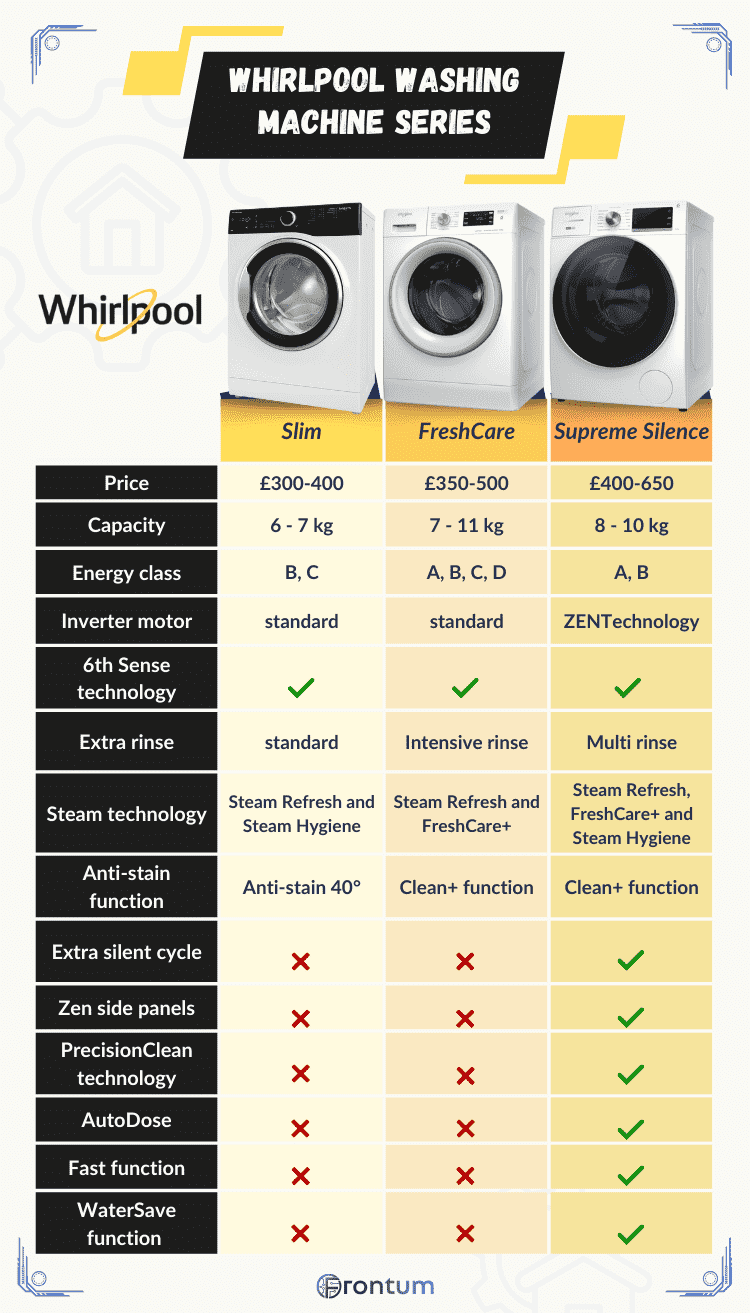
What is the warranty period for Whirlpool washing machines?
Whirlpool washing machines come with a legal warranty of 2 years. Product registration provides access to authorised technicians, original spare parts, and transport to the nearest Authorised Service Centre if needed. Extended warranty options are available through EasyCare and Repair&Protect.
The standard motor warranty is 2 years, but the ZENTechnology inverter motor has a 10-year warranty.
How much do Whirlpool washing machines cost?
Whirlpool washing machines are priced between £300 and £650, with an average cost of approximately £350, placing the brand #9 out of 19 in the price ranking. The average market price for washing machines is £380, so Whirlpool models are slightly below this average.
The most affordable models in Whirlpool’s range belong to the Slim series (WSB), with prices between £300 and £400, while the FreshCare series (FFB) goes up to £500. The most expensive models are part of the Supreme Silence series (W6/W7X/W8), with prices reaching £650.
Regarding the quality-price ratio, Whirlpool ranks #19 out of 22 brands, with an average score of 6.4.
Note: Brands with fewer than 6 products in the database were not included in the ranking.
The following chart illustrates the price distribution of Whirlpool washing machines.
[vertical-chart-78115155]
What should you consider when choosing the best Whirlpool washing machine?
When selecting a Whirlpool washing machine, consider its capacity, dimensions, energy consumption per 100 cycles, water consumption per cycle, spin-drying efficiency class, noise levels during washing and spinning, motor type, washing functions, and the number of available programs.
Front-loading or top-loading: which type of Whirlpool washing machine is better?
Whirlpool front-loading washing machines score higher overall than top-loading models (6.4 vs. 5.8 points) and offer more advantages. About 70% of Whirlpool washing machines are front-loading.
The distribution of Whirlpool washing machines by loading type is shown in the chart below.
[pie-chart-31836312]
Whirlpool front-loading washing machines have the following advantages over top-loading models.
- Higher capacity: Whirlpool front-loading machines have an average capacity of 9 kg, compared to 6 kg for most top-loading models.
- Larger drum volume: Front-loading machines have an average drum volume of 62 litres, compared to 42 litres for top-loading models.
- Lower energy consumption: Front-loading machines consume an average of 54 kWh per 100 cycles, versus 56 kWh for top-loading models.
- Better energy efficiency: Front-loading machines achieve energy efficiency class B, while top-loading machines average class C.
- Higher maximum spin speed: Front-loading machines typically reach a maximum spin speed of 1400 rpm, whereas most top-loading models max out at 1200 rpm.
What capacities are available for Whirlpool washing machines?
Whirlpool washing machines have capacities ranging from 6 to 10 kg. The most common capacities are 8 kg (31% of models) and 9 kg (25%). Drum volume ranges from 42 to 71 litres, with an average of 56 litres (below the market average of 58 litres).
The chart illustrates the distribution of capacities among Whirlpool washing machines.
[pie-chart-13310234]
The depth of Whirlpool washing machines ranges from 55 to 65 cm, so no slim models are available. Front-loading machines are approximately 60 cm wide, while top-loading models measure 40 cm, aligning with market standards.
What is the energy efficiency of Whirlpool washing machines?
Whirlpool washing machines have energy efficiency classes ranging from A to E. Specifically, 44% of models fall into class A, 19% into class B, 19% into class C, 6% into class D, and 13% into class E. No models are classified in classes F or G. In comparison, the market average shows about 39% of washing machines in class A and 17% in class B, so Whirlpool washing machines tend to have slightly lower energy classes than those of other brands.
The different Whirlpool series also vary in energy class: the Slim series ranges between classes B and C, the FreshCare series spans A to D, and the Supreme Silence series is between A and B.
The distribution of energy efficiency classes among Whirlpool washing machines is shown in the chart below.
[pie-chart-50306370]
In terms of energy consumption, Whirlpool washing machines consume between 48 and 78 kWh per 100 cycles, with an average of 54 kWh. This average places Whirlpool 8th out of 19 in the energy consumption ranking (compared to the market average of around 55 kWh per 100 cycles). Whirlpool class A machines consume less than 49 kWh per 100 cycles, while class B models stay below 55 kWh, with differences depending on the model’s capacity.
The water consumption of Whirlpool washing machines ranges from 43 to 52 litres per cycle, with an average of 48 litres. This places Whirlpool 17th out of 22 brands in the water consumption ranking.
What is the spin efficiency of Whirlpool washing machines?
The spin efficiency of Whirlpool washing machines falls into classes A to C, with class B being the most common. Specifically, 81% of Whirlpool washing machines are class B, 6% are class A, and 13% are class C. Spin efficiency measures the machine's ability to remove water from clothes and is closely linked to maximum spin speed.
The distribution of spin-drying efficiency classes among Whirlpool washing machines is illustrated in this chart.
[pie-chart-54805074]
Whirlpool washing machines have maximum spin speeds ranging from 1200 to 1600 rpm. 56% of models reach 1400 rpm, followed by 38% at 1200 rpm. This distribution aligns with the market average, where 60% of washing machines reach a maximum of 1400 rpm and 22% reach 1200 rpm. Higher spin speeds enable faster drying of clothes after washing.
However, also consider the minimum spin speed if you often wash delicate fabrics. Whirlpool washing machines have a minimum spin speed ranging from 400 to 600 rpm. About 30% of Whirlpool models can reach 400 rpm, below the market average where 67% of washing machines achieve this speed.
How noisy are Whirlpool washing machines?
Whirlpool washing machines are noisier than most other brands. Spin noise levels range from 70 dB to 85 dB, with an average of 78 dB. This places Whirlpool 16th out of 22 brands in the noise level ranking. In comparison, the market average for spin noise levels is 75 dB.
The noise level during spinning is the loudest part of the washing process and a key factor in noise measurement. Whirlpool washing machines have a noise emission class ranging from A to D, with most models (~50%) in class C (77–80 dB).
The chart below illustrates the distribution of spin noise levels among Whirlpool washing machine models.
[vertical-chart-91629790]
How many washing programs do Whirlpool washing machines offer?
Whirlpool washing machines typically have 14 washing programs, a number similar to that of most other brands.
The number of washing programs available on Whirlpool machines is distributed as illustrated in the chart below.
[vertical-chart-64935217]
The most common Whirlpool washing programs include Cotton, Whites, Mixed, Synthetics, Wool, Quick 30', Duvets, Delicates, Sports, Jeans, Eco 40-60, Cold Wash 20°C, and Refresh (with steam technology).
Some advanced models, such as those in the Supreme Silence series, offer additional programs, including Silent cycle (keeping noise below 60 dB throughout the cycle), Bed & Bath, Silk & Curtains, Baby Care, Plush Toys, Pet Items, Multi Color, and Anti-Stain.
Only 10% of Whirlpool washing machines feature a Shirts cycle (compared to 42% from other brands), a Baby Care cycle (10% compared to 39%), and an Anti-Allergy cycle (10% compared to 68%).
The Eco cycle lasts between 195 and 225 minutes, with an average of 215 minutes, slightly below the market average of 218 minutes. Whirlpool machines generally include 1–3 quick cycles under an hour, such as Quick 15', Quick 30', Full Load 45', and Refresh cycle.
Whirlpool washing machines include the following functions to customise cycles according to your needs.
- FreshCare+ (in FreshCare and Supreme Silence machines): Anti-crease function keeps laundry fresh through periodic drum movements for up to 6 hours.
- Quick Wash (available in Supreme Silence, top-loading, and integrated models): Reduces cycle duration.
- Intensive Rinse or Multi Rinse (in FreshCare and Supreme Silence series): Allows adding +1, +2, or +3 extra rinses after the standard rinse by pressing the corresponding button.
- Anti-Stain Clean+ (only in FreshCare series): Offers three washing levels – Intensive, Daily, and Fast.
- Steam Hygiene (in Supreme Silence series): Uses steam at the end of the cycle to remove 99.9% of bacteria without chemicals.
- WaterSave (in Supreme Silence series): Releases water from the top of the drum for more even distribution.
- Energy Saver (in some full-load models): Combines a lower temperature with slightly adjusted cycle duration to reduce energy use while maintaining excellent washing results.
- Colours 15° (in some top-loading models): Helps preserve the colours of clothes during low-temperature washing.
- Prewash (in some models): Performs a preliminary cycle to remove tougher dirt before the main wash.
No Whirlpool washing machines include the Water+ function, Soak function, or Wash Assist function.
What are the common features of Whirlpool washing machines?
Whirlpool washing machines usually include 6 to 10 features, with an average of 8 features (below the market average of 10 features).
The distribution of the number of features among Whirlpool machines is presented in the chart below.
[vertical-chart-63323707]
Almost all Whirlpool washing machines have the following features.
- Laundry detection system (6th Sense Technology): Automatically adjusts washing parameters (temperature, water level, motor torque) based on load size and fabric type.
- Foam control system: Detects and removes excess foam during washing cycles.
- Unbalanced load detection: Alerts the user to an unbalanced load (without automatically redistributing laundry in the drum).
- Delay start option: Allows scheduling the start of the washing cycle up to 24 hours in advance.
Other common features of Whirlpool washing machines include the following.
- Steam technology (in FreshCare and Supreme Silence series): FreshCare+ system uses steam and gentle movements to keep clothes fresh and prevent odours.
- AquaStop (15% of Whirlpool washing machines): A safety system that blocks water in case of leaks.
- Overflow protection (15% of Whirlpool washing machines): Automatically removes excess water in the drum.
- Soft-opening door (for top-loading machines only; 30% of Whirlpool machines): Makes it easier to open the lid for convenient loading and unloading.
- Automatic drum positioning (for top-loading machines only; 30% of Whirlpool machines): Automatically repositions the drum for easier unloading.
- Program progress bar (in some FreshCare series models): Allows tracking the progress of washing cycles.
Some advanced Whirlpool models (Supreme Silence series) also include the following features.
- AutoDose system: Uses sensors to dispense the exact amount of detergent and softener needed for each load based on weight and dirtiness. It can hold enough detergent for 26 cycles.
- PrecisionClean technology: Powerful water jets focus directly on dirt, not fibres, for optimal washing results.
- Sound insulation design: Zen panels and structure reduce noise and absorb vibrations.
- Drum light: Illuminates the drum interior when the door is open for better visibility.
However, Whirlpool washing machines lack the following features found in other brands.
- Load balancing system (43% of all washing machines)
- Pre-mix technology (found in 24% of all washing machines)
- Wi-Fi connectivity (23% of all washing machines)
- AI technology (11% of all washing machines)
- Self-cleaning/Drum clean function (66% of all washing machines)
- Special drum design for better care of delicate clothes (46% of all washing machines)
- Automatic drawer cleaning (12% of all washing machines)
- Memory function (36% of all washing machines)
- Smart diagnosis function (43% of all washing machines)



